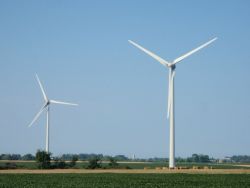On Monday, the Ontario Superior Court of Justice released a decision dismissing claims that opponents of wind power brought against the Fairview Wind Farm in Clearview Township. Basically, the plaintiffs (several residents in Clearview Township who oppose the wind farm) sought damages and an injunction against the wind farm developer. The court’s decision brings an end to the case, deciding that a full trial wasn’t even necessary, because the plaintiffs were “unable to show that a trial is needed to determine whether the plaintiffs have a cause of action at this time,” (paragraph 5).
In lawyer speak, the Honourable Madam Justice Healey granted “summary judgment,” dismissing all of the plaintiffs’ claims. She decided this because the wind farm was not under construction — in fact, it hadn’t even obtained regulatory approvals. So, under the law, the plaintiffs had no claim. This is what the defendants (the wind farm developer and the site’s landowners) argued and what the court accepted.
"...Did the court really accept as fact that wind farms decrease property values? The short answer is a resounding 'no.'"
But if you’ve heard any news about this case, it is likely from the anti-wind organizers that have spun a different story, leaving many wondering: did the court really accept as fact that wind farms decrease property values?
The short answer is a resounding “no.”
Unfortunately, the spin from the lawyer for the wind opponents and the misunderstanding of a vocal anti-wind group have misconstrued the judge’s reasons to their benefit, engaging in two significant mischaracterizations, which media coverage has perpetuated (e.g., see here and here). The wind developer has issued a press release to try to help repair these before they spread further, but here are the basics.
First: does the court’s decision open a door to claims?
“It now seems clear that as soon as a project is approved residents can start a claim.” — Eric Gillespie, lawyer for the plaintiffs.
 This mischaracterization is based on Justice Healey’s statement that her decision dismissing all of the claims before her was “without prejudice to the plaintiffs' rights to commence an action for identical or similar relief when and if the Fairview Wind Project receives the necessary approvals to be constructed,” (paragraph 6).
This mischaracterization is based on Justice Healey’s statement that her decision dismissing all of the claims before her was “without prejudice to the plaintiffs' rights to commence an action for identical or similar relief when and if the Fairview Wind Project receives the necessary approvals to be constructed,” (paragraph 6).
The reality is that courts do not decide issues that are hypothetical, only the specific issues before them. This is a central feature of our legal system.
And it’s an important one. Courts recognize that deciding issues or cases that are only in the abstract, without concrete facts, is a dangerous way of making decisions; it’s best to leave those decisions to the case when, and if, one actually comes.
So, when the court says that this decision is “without prejudice” to a potential future case, it is really just restating a rule that binds its actions anyway. Its decision on the issue before it was based on the simple fact that the planning stage of the wind farm was too early for the plaintiffs to have a legitimate claim. But such a decision cannot have impact on a later claim.
Justice Healey didn’t really need to say it, but judges often make this comment. I have worked closely with judges and I’ve seen it quite often. It makes it explicitly clear what the law already requires (I think it also takes the sting out of losing).
But Mr. Gillespie’s assertion that a “door has been opened” isn’t totally surprising — his firm has been busy bringing a lot of cases (at least 10) against wind farms over the last few years. And, as he says in his own words, based on his characterization of the court’s statement, “We can definitely expect more claims now that this door has been opened.”
Second: does the court accept, as fact, the plaintiff’s evidence that wind farms reduce property values?
“Wind corporations and politicians have been saying for many years that wind turbines don’t devalue property. … This is a court finding that they do, even before a project has been approved and constructed.” — Mr. Gillespie.
"The judge accepts unreservedly that property value is lost for neighbours of these power projects based on the evidence. He [sic] also accepted that the possibility of adverse health effects from the environmental noise.” — Jane Wilson, Wind Concerns Ontario president.
“An Ontario court says that landowners near a proposed wind farm have suffered diminished property values.” — John Spears, Toronto Star.
These mischaracterizations are based on the following statement from Justice Healey (the sound bite that Mr. Gillespie’s firm used in its press release is emphasized):
“Even though in this case the court accepts that the plaintiffs have suffered, and are currently suffering, losses culminating in diminished property values, as the evidence exists today the plaintiffs are unable to prove that they have been wronged by the defendants. They have not presented any evidence linking the diminution of property values to any tortious conduct.”
In reality, the “sound bite” (emphasized in the quote above) demonstrates a bit of an unfortunate choice of words that can be misleading when taken in isolation. But we need to read this statement in context.
Courts make “findings of fact” at trial on issues that are before it. That is not what this was. For the defendants to win on their summary judgment request — to have the case dismissed without needing to determine the facts at trial — they had to show a legal reason to dismiss the case that is not based on facts. The defendants’ position was that the law does not recognize a legal claim when the allegedly harmful development doesn’t even have the necessary approvals.
"... Even accepting their evidence, the plaintiffs still lost,"When they undertake a summary judgment decision, courts often engage in a useful mental exercise that basically goes like this: if the defendants in the case want the case dismissed without having to try the facts, they could show that they would win, under the law, regardless of what the real facts are. The best way to test this is to accept the other side’s version of the facts then see if they could ever possibly win on this claim. If not, everyone (including the overtaxed judicial system) saves time by ending the case right then and there.
It’s clear that this is what the court was doing, if you read Justice Healey’s reasons (i.e., all of them): “the court was invited by the [wind farm defendants] to take the plaintiffs' evidence as proven in order to place the plaintiffs' cases at their most favourable for the purpose of these motions,” (paragraph 8). Because this is what the court agreed to do, the court then went on to review the plaintiffs’ evidence — not by accepting it as “the truth” or its own findings of the facts, but by considering it, for the purposes of this useful mental exercise, as the only evidence on which to base its decision. And even accepting their evidence, the plaintiffs still lost – end of the road.
Conclusion
So, did the court make a “finding” or “accept unreservedly” that wind farms reduce property values? No. It undertook a thought experiment, suggested by the defendants, in order to show that there was no way the plaintiffs could ever win this case, even if their version of facts was accepted.
Does the fact that the court accepted this evidence for the purposes of this exercise impact the evidence on property values in the future? Again, no. Any plaintiff that relies on this judgment to show that wind farms cause losses in property values is setting themselves up for failure. Various people can spin this decision to convince the public — in particular, potential future litigants — that the court did something that it did not actually do, but no future judge will fall prey to that mistake.
Perhaps this decision will embolden opponents to bring legal challenges to wind farms, but that would be in error. This decision opens no new door to legal claims against wind farms, nor does it bolster the acceptance of the wind opponents’ “evidence” in the courts. It does, however, open the door for Mr. Gillespie to attract new clients.
All that can be said about this decision is that wind energy opponents lost in court on a claim brought at this early stage of a wind farm’s development — end of story.









